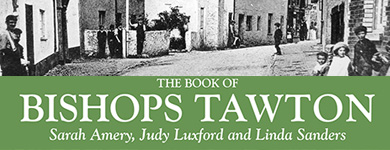Bishop’s Tawton has in it’s parish 4268 acres of land and around 1200 residents. It is one of the oldest parishes in Devon and St. John the Baptist Church, a grade 1 listed building and landmark in the village, is said to be the oldest church in the county. This has a 14th. Century spire, and the baptismal font is Norman.
It is often reported that Bishop’s Tawton was a very early See for the Bishop of Exeter until Putta, the second bishop, removed the See to Crediton. Although widely believed and often written, this has been difficult to prove and the debate goes on. It is thought that the bishop continued to have a palace in the village long after the See was removed and traces of the original palace building have been incorporated into the house at Court Farm.
During the English Civil War a fierce confrontation between the Roundheads and Cavaliers was fought across the Taw. Canon balls fired during this battle lodged into the walls of Court Farm and are still in existence today.
The more recent history of the village has been uncovered by the “Memories” project. Members of the Community Ladies group collected oral histories, old photos and other memorabilia to draw up a picture of village life over the last two centuries and displayed the information at a very successful exhibition in the village hall early in 2012, with more than 600 visitors coming through the doors.
Farming has always played an important part in Bishop’s Tawton life and during the latter part of the 19th and into the 20th. Century there were no fewer than twenty four farms in the parish. Bishop’s Tawton village was the hub of this local farming community and before the advent of the car and easier transport links to Barnstaple it was a very self contained community. There were two mills in the parish, grinding corn and a saw mill. There was a Blacksmith and an agricultural engineering business as well as shops that could provide you with all you needed for daily living, food, sweets, newspapers, shoe menders, and even knitting wool and radio parts!
There was a lively social scene, with a strong WI, local drama groups, a “Save the Village Hall” committee putting on various events. There were village fetes and tea dances and Christmas lunches for the over 60’s.
Sport played a very important role in village life. There were local cricket and football teams going back to the early 1900s and Bishop’s Tawton badminton club reached it’s peak in the late 1970’s becoming the first North Devon club to reach the county finals.
Bishop’s Tawton has had several famous residents, a well known football player, a notorious suffragette and the arresting officer of “the Man they Couldn’t Hang” have all resided in the village. In addition to these claims to fame, The Thomas Corn Drill was invented in Bishop’s Tawton and has been exported all over the world.
The “Memories” project continues and following numerous requests the information collected is being collated and prepared for publication during 2014. The Book of Bishops Tawton will be launched next year and you will be able to pre-order a copy and see your name in print. Watch the website for more information about this. Anyone with further information about Bishop’s Tawton’s past is welcome to contact Judy Luxford on 01271 345189.



